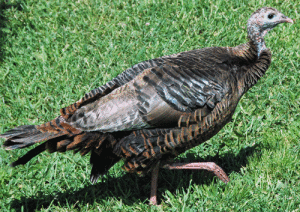
A female wild Turkey
Photo credit: James St. John, CC BY 2.0 <https://creativecommons.org/licenses/by/2.0>, via Wikimedia Commons
While doing my doctoral research, I spent many days tromping around in the middle of a pine forest in Mississippi. The pine trees were planted in rows, some with really thick plants underneath that you couldn’t see more than a few feet in front of you at a time, and some open and vibrant with flowering and fruit vines. I saw a variety of wildlife in those woods, ranging from birds to toads to bobcats. But the one animal that I always steered clear of was the wild turkey.
Wild turkeys used to be quite abundant in Texas, but overhunting and habitat destruction caused their numbers to sharply decline in the late 1800s. Thankfully, turkey numbers have been largely restored in eastern Texas.
The turkey is a gallinaceous bird, meaning it is in the same order of birds as domestic poultry and other game birds like grouse. Turkeys are easily identified, though it’s likely more people have seen one served at Thanksgiving than actually alive in the wild. Turkeys have strong feet and legs, and short wings that allow them to fly quickly but only for short distances. Most people know turkeys by their tail, which is well developed and creates a beautiful fan and by the wattle, the flap of bumpy red skin that hangs down off of a male’s face. But what always worries me the most are the formidable spurs that become apparent when I get a look at a turkey’s leg.
Each physical adaptation has a purpose. Turkeys use their large tail during flight, for stabilizing, steering, and braking. Equally as important, the tail serves another purpose – as a display for attracting mates and establishing social status and dominance hierarchies. Wattles allow the bird to get rid of excess heat on hot days. Wattles can also turn bright scarlet during mating displays, or blue when approached by a possible predator. Spurs are used to establish dominance and for defense, with the size of the spur often indicating an older turkey. Spurs are made of keratin, similar to a rhinoceros’s horn or a bear’s claws.
During the turkey’s breeding season, hormones ramp up and male turkeys can become defensive and aggressive. Turkeys may even try to dominate or attack people they view as a threat or subordinate, and may start trying to peck, follow, and intimidate people who get too close. And those spurs on their legs can do some damage! Imagine being chased by a turkey; I haven’t had the pleasure yet but I’m sure it could be quite unsettling. One of the researchers I worked with a while back said wild turkeys were one of the few things that he always avoided in the woods because of these behaviors. Turkeys can be bold and yet easily scared, but not once they are already running towards you!
As we approach the Thanksgiving holiday, see if you can find a wild turkey out in the country before you sit down to enjoy one at your table. They really are amazing birds, even if they aren’t as vibrant in color as many of our songbirds. Turkeys provide both economic and social value, and are predator and prey at different points in their lifecycle, which enhances ecosystem biodiversity wherever they live. This year, give thanks for the return of one of the traditional game species, and stop and appreciate the many benefits they provide.
